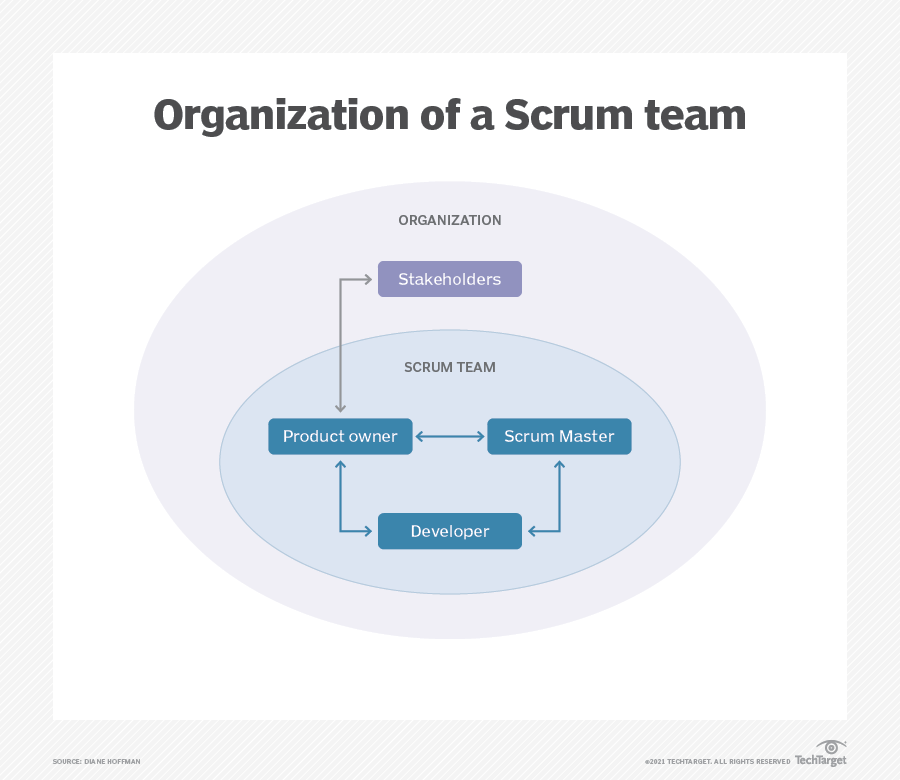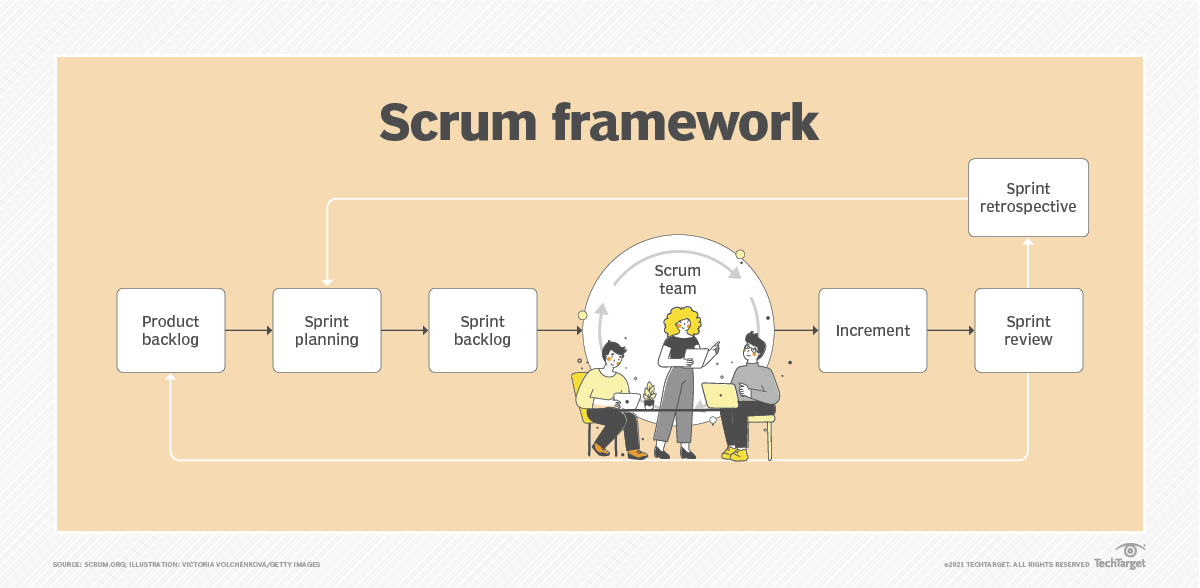By Chandana
on Jul 24, 2023
What is Scrum?Scrum project management is a technique that prioritizes iterative and incremental product delivery through constant feedback and collaborative decision-making. Scrum fixes time and costs to control requirements using collaborative ceremonies, time boxes, frequent feedback cycles, and a prioritized product backlog.
 What Is Scrum Framework?
What Is Scrum Framework?The product owner creates a product backlog (essentially, a wishlist of tasks that need to be prioritized in a project)
The Scrum team conducts a sprint planning session where the tasks necessary to complete items on the wishlist is broken down into small, more easily manageable chunks
The team creates a sprint backlog and plans its implementation
The team decides a time duration for every sprint (the most common intervals is probably two weeks)
The team gets together every day for a brief Scrum meeting (often referred to as a Daily Standup) where each member of the team shares daily updates, helping the team and the project manager assess the progress of the project
The certified Scrum Master guides the team and keeps them focused and motivated
The stakeholders and the product owner conduct a review at the end of each sprint
This is the cycle followed by a Scrum team in a product development project. The three roles mentioned above - the Product Owner, the Scrum Team, and the ScrumMaster together play a major role in exercising this framework.
What is Scrum in Project Management?Scrum methodology entails a small team led by a Scrum Master, who is accountable for eliminating obstacles and ensuring timely completion of tasks. The team holds daily meetings to discuss allotted work and obstacles that must be dealt with. Scrum project management ensures quick development, rapid testing, and effective management of projects, particularly within a small team.
The Application of Scrum in Project ManagementThe Scrum project management technique is employed through meetings or ceremonies. Scrum ceremonies usually include the daily Scrum, sprint planning meeting, sprint review, and sprint retrospectives. The team works in time boxes that are the sprints. An optional aspect is the release planning meetings which enable the forecast and planning of various groups of sprints.
Sprint Planning MeetingDuring the sprint planning meeting on the first day of each sprint, the Scrum Master, Product Owner, and team collaborate. The ‘what’ and ‘how’ are discussed in the meeting. The Product Owner shares the features that must be completed in the sprint while the team determines the required tasks.
The team then reviews its workload to assess if all features can be completed in the sprint. If not, lower-priority features are returned to the product backlog until the workload lessens for the team to commit to the sprint.
Tracking ProgressFollowing the sprint-planning meeting and team commitment, progress is tracked in Scrum project management through prominent information radiators such as the task board and burndown chart. The task board visually represents the tasks required for each feature, with columns typically labeled ‘To Do,’ ‘Doing,’ and ‘Done.’
The burndown chart shows the amount of pending work via trend lines. Daily scrum meetings are conducted at the task board, and adjustments are made as the team discusses completed tasks, tasks planned for the current day, and any obstacles faced.
Sprint ReviewAfter the sprint’s completion, the team holds a sprint review meeting where stakeholders are invited to provide feedback on the features demonstrated. The Product Owner documents and incorporates the feedback into the product backlog as necessary.
Subsequently, the team conducts a retrospective meeting without the stakeholders to reflect on their performance and determine areas of improvement. A plan of action is created, with items implemented during the following sprint and reviewed during the subsequent retrospective.
Release PlanningRelease Planning is integral to Scrum project management, allowing for long-term planning over multiple sprints. During the release-planning meeting, the entire team attends as the Product Owner presents the desired features for the quarter. The team provides rough estimates to identify the feasible features per sprint and the total number of features that can be completed by the end of the quarter. Release planning can be feature-driven, time-driven, or cost-driven.
Advantages and Disadvantages of Scrum Project ManagementAdvantages of ScrumHere's why the framework is so popular today:
Scrum can help teams complete project deliverables quickly and efficiently.
Scrum can help teams complete project deliverables quickly and efficiently
Scrum ensures effective use of time and money
Large projects are divided into easily manageable sprints
Developments are coded and tested during the sprint review
Works well for fast-moving development projects
The team gets clear visibility through scrum meetings
Scrum, being agile, adopts feedback from customers and stakeholders
Short sprints enable changes based on feedback a lot more easily
The individual effort of each team member is visible during daily scrum meetings
Disadvantages of ScrumBut like every framework, scrum also has few disadvantages.
Nothing is perfect, and the Scrum methodology is no exception. In some cases, Scrum is combined with other project management techniques that can help resolve some of these drawbacks:
Scrum often leads to scope creep, due to the lack of a definite end-date
The chances of project failure are high if individuals aren't very committed or cooperative
Adopting the Scrum framework in large teams is challenging
The framework can be successful only with experienced team members
Daily meetings sometimes frustrate team members
If any team member leaves in the middle of a project, it can have a huge negative impact on the project
Quality is hard to implement until the team goes through an aggressive testing process
Scrum RolesThe agile technique, which includes the Scrum framework, entails managing a project by breaking it down into several parts and going through the cycle of planning, carrying out, and assessing at each stage. The cycles of Scrum are known as sprints, and they normally span between two and four weeks. After each sprint, the complete body of work is reviewed. The participants play three different roles in the process: the product owner, who represents the organization, the scrum master, who serves as the project manager and a group of individuals who carry out the tasks.
Scrum is particularly helpful in the software development industry since it helps a team concentrate on a smaller goal before integrating it with the project's primary goal. However, its qualities can be used for a wide range of projects across numerous industries, particularly those that call for quick responses to urgent requests and a flexible project development team.
Comprehending the Role of Project Manager in Scrum – The Scrum Master vs. the Project ManagerIn Scrum, the Project Manager is responsible for overseeing the entire project, which encompasses managing risks, budgets, and other aspects. The Scrum Master has a much more specialized role, ensuring that the team follows Scrum principles thoroughly and properly.
The Scrum Master is the Agile team’s guide, leader, and consultant. The Scrum Master acts as an agile expert. A Project Manager, on the other hand, negotiates project details, manages risk and time, and cooperates with the stakeholders, other project managers, and clients.
Scrum Project Management: Advantages and Disadvantages
By Chandana
Last updated on Jul 24, 202313217701
Scrum Project Management: Advantages and Disadvantages
Table of Contents
What is Scrum?What Is Scrum Framework?What is Scrum in Project Management?The Application of Scrum in Project ManagementAdvantages and Disadvantages of Scrum Project ManagementView More
Supercharge your career with CSM Certification at Simplilearn. Gain in-demand skills, boost your marketability, and unlock exciting job opportunities. Enroll now!
Scrum is a popular framework that works very well for innovative and complex product development projects. However, it has its disadvantages too. But before we jump into its pros and cons, let’s understand the what Scrum is.
Are you a professional who is aspiring to be a Certified ScrumMaster? Then check out the CSM Certification Training Course now!
Get Up to $165k Salary After Passing CSM Exam
Certified ScrumMaster® Certification TrainingEXPLORE COURSEGet Up to $165k Salary After Passing CSM Exam
What is Scrum?
Scrum project management is a technique that prioritizes iterative and incremental product delivery through constant feedback and collaborative decision-making. Scrum fixes time and costs to control requirements using collaborative ceremonies, time boxes, frequent feedback cycles, and a prioritized product backlog.
Check out Simplilearn's video on "Introduction to Scrum Master Certification" curated by our industry experts that will help you understand what is scrum and its methodologies.
What Is Scrum Framework?
The product owner creates a product backlog (essentially, a wishlist of tasks that need to be prioritized in a project)
The Scrum team conducts a sprint planning session where the tasks necessary to complete items on the wishlist is broken down into small, more easily manageable chunks
The team creates a sprint backlog and plans its implementation
The team decides a time duration for every sprint (the most common intervals is probably two weeks)
The team gets together every day for a brief Scrum meeting (often referred to as a Daily Standup) where each member of the team shares daily updates, helping the team and the project manager assess the progress of the project
The certified Scrum Master guides the team and keeps them focused and motivated
The stakeholders and the product owner conduct a review at the end of each sprint
This is the cycle followed by a Scrum team in a product development project. The three roles mentioned above - the Product Owner, the Scrum Team, and the ScrumMaster together play a major role in exercising this framework.
Elevate Your Agile Skills with CSM Certification - Simplilearn Delivers Excellence!
Get Up to $165k Salary After Passing CSM Exam
Certified ScrumMaster® Certification TrainingEXPLORE COURSEGet Up to $165k Salary After Passing CSM Exam
What is Scrum in Project Management?
Scrum methodology entails a small team led by a Scrum Master, who is accountable for eliminating obstacles and ensuring timely completion of tasks. The team holds daily meetings to discuss allotted work and obstacles that must be dealt with. Scrum project management ensures quick development, rapid testing, and effective management of projects, particularly within a small team.
The Application of Scrum in Project Management
The Scrum project management technique is employed through meetings or ceremonies. Scrum ceremonies usually include the daily Scrum, sprint planning meeting, sprint review, and sprint retrospectives. The team works in time boxes that are the sprints. An optional aspect is the release planning meetings which enable the forecast and planning of various groups of sprints.
Sprint Planning Meeting
During the sprint planning meeting on the first day of each sprint, the Scrum Master, Product Owner, and team collaborate. The ‘what’ and ‘how’ are discussed in the meeting. The Product Owner shares the features that must be completed in the sprint while the team determines the required tasks.
The team then reviews its workload to assess if all features can be completed in the sprint. If not, lower-priority features are returned to the product backlog until the workload lessens for the team to commit to the sprint.
Tracking Progress
Following the sprint-planning meeting and team commitment, progress is tracked in Scrum project management through prominent information radiators such as the task board and burndown chart. The task board visually represents the tasks required for each feature, with columns typically labeled ‘To Do,’ ‘Doing,’ and ‘Done.’
The burndown chart shows the amount of pending work via trend lines. Daily scrum meetings are conducted at the task board, and adjustments are made as the team discusses completed tasks, tasks planned for the current day, and any obstacles faced.
Sprint Review
After the sprint’s completion, the team holds a sprint review meeting where stakeholders are invited to provide feedback on the features demonstrated. The Product Owner documents and incorporates the feedback into the product backlog as necessary.
Subsequently, the team conducts a retrospective meeting without the stakeholders to reflect on their performance and determine areas of improvement. A plan of action is created, with items implemented during the following sprint and reviewed during the subsequent retrospective.
Release Planning
Release Planning is integral to Scrum project management, allowing for long-term planning over multiple sprints. During the release-planning meeting, the entire team attends as the Product Owner presents the desired features for the quarter. The team provides rough estimates to identify the feasible features per sprint and the total number of features that can be completed by the end of the quarter. Release planning can be feature-driven, time-driven, or cost-driven.
Get Up to $165k Salary After Passing CSM Exam
Certified ScrumMaster® Certification TrainingEXPLORE COURSEGet Up to $165k Salary After Passing CSM Exam
Advantages and Disadvantages of Scrum Project Management
Advantages of Scrum
Here's why the framework is so popular today:
Scrum can help teams complete project deliverables quickly and efficiently.
Scrum can help teams complete project deliverables quickly and efficiently
Scrum ensures effective use of time and money
Large projects are divided into easily manageable sprints
Developments are coded and tested during the sprint review
Works well for fast-moving development projects
The team gets clear visibility through scrum meetings
Scrum, being agile, adopts feedback from customers and stakeholders
Short sprints enable changes based on feedback a lot more easily
The individual effort of each team member is visible during daily scrum meetings
Disadvantages of Scrum
But like every framework, scrum also has few disadvantages.
Nothing is perfect, and the Scrum methodology is no exception. In some cases, Scrum is combined with other project management techniques that can help resolve some of these drawbacks:
Scrum often leads to scope creep, due to the lack of a definite end-date
The chances of project failure are high if individuals aren't very committed or cooperative
Adopting the Scrum framework in large teams is challenging
The framework can be successful only with experienced team members
Daily meetings sometimes frustrate team members
If any team member leaves in the middle of a project, it can have a huge negative impact on the project
Quality is hard to implement until the team goes through an aggressive testing process
Scrum Roles
The agile technique, which includes the Scrum framework, entails managing a project by breaking it down into several parts and going through the cycle of planning, carrying out, and assessing at each stage. The cycles of Scrum are known as sprints, and they normally span between two and four weeks. After each sprint, the complete body of work is reviewed. The participants play three different roles in the process: the product owner, who represents the organization, the scrum master, who serves as the project manager and a group of individuals who carry out the tasks.
Scrum is particularly helpful in the software development industry since it helps a team concentrate on a smaller goal before integrating it with the project's primary goal. However, its qualities can be used for a wide range of projects across numerous industries, particularly those that call for quick responses to urgent requests and a flexible project development team.
Become a Skilled Agile Professional
PMI ACP Training CourseEXPLORE PROGRAMBecome a Skilled Agile Professional
Comprehending the Role of Project Manager in Scrum – The Scrum Master vs. the Project Manager
In Scrum, the Project Manager is responsible for overseeing the entire project, which encompasses managing risks, budgets, and other aspects. The Scrum Master has a much more specialized role, ensuring that the team follows Scrum principles thoroughly and properly.
The Scrum Master is the Agile team’s guide, leader, and consultant. The Scrum Master acts as an agile expert. A Project Manager, on the other hand, negotiates project details, manages risk and time, and cooperates with the stakeholders, other project managers, and clients.
6 Steps of Scrum ProcessThe following procedures make up the Scrum framework:
The product owner compiles a list of all the tasks necessary to complete the project, and is known as the product backlog.
The Scrum team reviews the product backlog and breaks down all significant tasks into more manageable, smaller ones.
The group then determines how to implement it and builds a sprint backlog.
Each sprint's length is chosen, with a typical duration of between two and four weeks.
For the period of a sprint, the team typically meets daily, with each member providing an update and the project manager assessing the project's progress based on the most recent information.
The product owner and the stakeholders of the organization examine the outcomes after each sprint.
Key Scrum Tools to Get You Through Your Next SprintJira: One of the most well-known agile management tools is Jira by Atlassian. For major commercial enterprises as well as IT and software development firms, it is an excellent Agile project management alternative.
Trello: Without including Trello, one of the most popular task and project management tools globally, no list of Scrum tools would be complete. Trello is a clear and visible tool for seeing what has to be done. Built for teams of all sizes, it is an easy and quick method to get organized and boost team productivity. Trello is a fantastic tool for various projects and fields, from software development to recruiting and marketing efforts, thanks to its adaptability, many tools for diverse purposes, and customization choices. You can use this tool to improve process organization, whether creating new software, managing your social media presence, or arranging an email campaign.
Zoho Sprints: A cloud-based Scrum solution for project planning and tracking is called Sprints by Zoho. The program is easy to use and was created with agile methods in mind. Zoho Sprints is very simple to use and takes little time to get started with.
Despite its seeming simplicity, Zoho provides all the necessary agile tools for planning and successfully completing your projects. Use it to organize your content, assign tasks, schedule meetings, build dashboards and backlogs, and support other Scrum activities. Make sure to express gratitude and inspire your staff to keep everyone moving in the same direction in order to improve the process.
Active Collab: For creative workers, Active Collab is an all-in-one agile project management application. In addition to the standard features Scrum tools have, including adding and assigning tasks, several extra tools are available. You can use Active Collab to manage project budgets, keep a tab on time tracking and reporting tools, view the tasks as a calendar, boards, or lists while creating a mobile app or software, manage a tech company, or simply begin an internet business.
Scrumwise: Scrumwise, a straightforward and user-friendly application that enables you to concentrate on the important aspects of your project, is another option on our list of Scrum project management tools.
Scrumwise can be the ideal solution if you're seeking a comprehensive tool to handle your Scrum technique without more hassle. Simplify task management by organizing the tasks into checklists and monitoring the completion percentage so that you always know where your project is.
Becoming a Certified Scrum MasterTaking a CSM course with a Certified Scrum Trainer is the first step to becoming a certified scrum master. You can join Simplilearn's Certified ScrumMaster Certification Training Course to learn about the scrum framework during a two-day (14–16 hour) live training. You'll have to take an exam after finishing the course, and you'll need to get 37 out of 50 questions right. After passing your test, you will receive your CSM certification.
Source: Simplilearn
Original Content: https://shorturl.at/bksMT
















